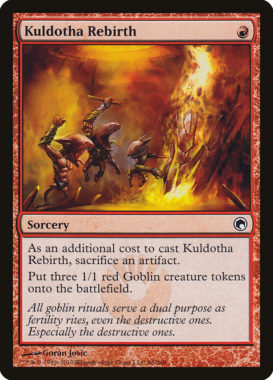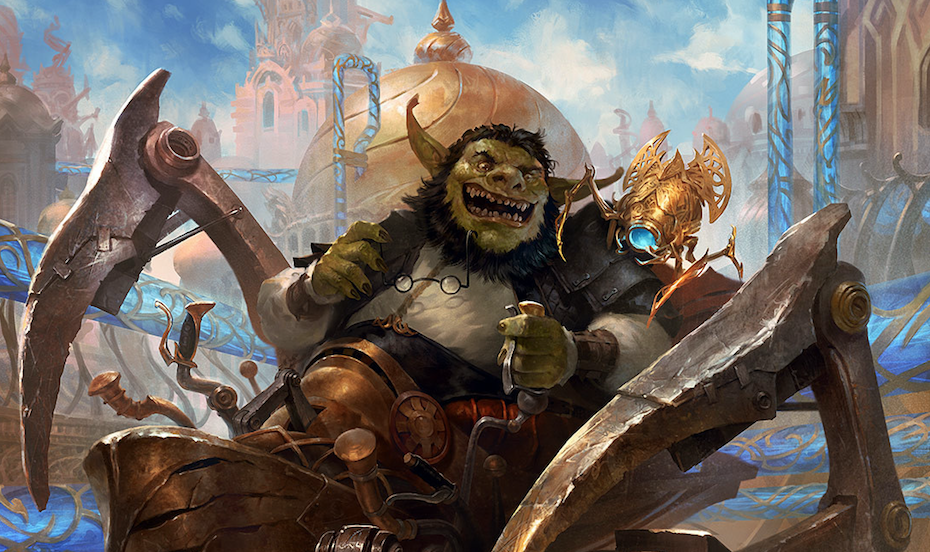One of the really fun parts of playing Oathbreaker is the unique deckbuilding. Although there may be more popular options for certain Oathbreakers, there are often many different ways one can build a deck around a planeswalker, similar to choosing a Commander in EDH. The added component of the Signature Spell adds even more to the realm of possibilities. In this series, New Perspectives, I will be looking at individual Oathbreakers and some of the many ways they can be built around. I’ve decided to start off the series by writing about my favorite Oathbreaker, Daretti, Ingenious Iconoclast. For this particular article, I’ve also decided to add in another spicy restriction: all of the included lists will also be using the same Signature Spell, Kuldotha Rebirth.
The Oathbreaker
Let’s start by looking at Daretti’s abilities.

This first ability is simple, but it does offer a consistent way to make chump blockers to protect Daretti. On top of that, the tokens counting as both artifacts and creatures opens up numerous ways to potentially take advantage of this regular resource. It is a little unfortunate that the tokens can’t attack, but as 1/1s they probably weren’t going to be getting in for much damage anyways.

Even in a non-artifact-themed deck, this ability can always be fueled by Daretti’s +1. It’s nothing flashy, but being able to snipe a creature or artifact, for only one loyalty, can be very handy. Liquimetal Coating is a card that works particularly well with this effect, giving you the ability to destroy any kind of permanent.

At a cost of 6 loyalty, this ability probably isn’t something you want to plan on using every game. This effect is surprisingly flexible, letting you target an artifact in anyone’s graveyard or under anyone’s control. Even if not used often, I could definitely see this ability occasionally turning the tide in some games out of nowhere.

Last, but not least, is the Signature Spell. Kuldotha Rebirth‘s (KR) artifact requirement can easily be met by using Daretti’s +1, and at a cost of only 1 red mana, it is very possible to cast KR multiple times in one game. Unlike Daretti’s 1/1 defenders, these goblins can also attack and pressure opposing Oathbreakers when needed. KR offers Daretti lists a little extra fuel that can be utilized in a number of different ways.
Build #1: Artifacts
Decklist: Daretti Artifacts
Daretti was obviously designed to work well in decks built around artifacts. More specifically, Daretti is built well for decks sacrificing artifacts to generate more value. His +1 can help fuel this strategy, and both his -1 and our Signature Spell can be effective sacrifice outlets. This particular strategy is largely defined by 3 main types of cards: sacrifice fodder, sacrifice outlets, and artifact payoffs.
- Sacrifice Fodder: Ichor Wellspring, Mycosynth Wellspring and Servo Schematic all provide value upon entering the battlefield and hitting the graveyard. Cathodion, Filigree Familiar, Hangarback Walker and Perilous Myr are some artifact creatures that fill a similar role. Ugin, the Ineffable provides a steady stream of 2/2s that also generate card advantage upon death.
- Sacrifice Outlets: Goblin Welder, Pia and Kiran Nalaar, and Priest of Forgotten Gods are all creatures that can sacrifice our artifacts and creatures for even more value. Goblin Bombardment costs zero mana to activate and can repeatedly ping opposing creatures, players and planeswalkers. Phyrexian Tower acts as a “sol land” pretty consistently in this deck, given all of our sacrifice fodder.
- Artifact Payoffs: Scrap Trawler adds a bit of resiliency to our game plan, and helps keep the train rolling with sacrificing our artifacts. Etched Champion is a threat that’s difficult to answer, even more so when buffed up by equipment. Mystic Forge offers a lot in the way of card advantage, given that almost half of the cards in this list can be played off of it. Karn, Scion of Urza also adds a bit of card advantage, plus his constructs can effectively keep opposing Oathbreakers in check, if not end the game outright.
- House Rule: It’s important to note that I made this list taking into account a house rule from my own playgroup. We allow players to build 10-card “wishboards” that can be accessed with certain cards, in this case Karn, the Great Creator. Not every playgroup is okay with this house rule, so definitely check in about it before playing a game with a wishboard. Even if your playgroup doesn’t allow this house rule, it’s easy enough to swap out this Karn for something else.
Build #2: Aristocrats
Decklist: Daretti Aristocrats
An artifact build isn’t the only way we can sacrifice creatures for value. Daretti and KR also function well at the head of a more traditional aristocrats strategy. Similar to our first build, this list will largely be reliant on sacrifice fodder and sacrifice outlets. The main difference between the two strategies is that instead of building towards payoffs for playing artifacts, this aristocrats list utilizes more general sacrifice payoffs.
- Sacrifice Fodder: Carrier Thrall, Doomed Dissenter, Grim Initiate, Mogg War Marshal and Orzhov Enforcer all leave behind an additional creature after they die, which can then be used for even more sacrifice shenanigans. Reassembling Skeleton and Ophiomancer‘s snakes can be sacrificed repeatedly. Perilous Myr, Dreadhorde Butcher and Vindictive Lich pack an extra punch when they die and can help close out a game.
- Sacrifice Outlets: Falkenrath Aristocrat, Viscera Seer, and Yahenni are all free, repeatable sacrifice outlets that keep our engine going. Yawgmoth‘s sacrifice ability technically comes at a cost of 1 life, but some of our payoffs will balance that out. Witch’s Oven makes artifact food tokens for us (yes we’re running Cauldron Familiar), and Recurring Nightmare is a sacrifice outlet that doubles as recursion. Diabolic Intent, Spark Harvest and Heartfire are one-time sacrifice outlets stapled onto some sweet spells. God-Eternal Bontu and Westvale Abbey are also only one-time sacrifice outlets, but they come with some huge upsides.
- Sacrifice Payoffs: Blood Artist, Falkenrath Noble and Zulaport Cutthroat give us ways to drain our opponents out of the game as our creatures die. Hissing Iguanar, Mayhem Devil and Judith don’t gain us life, but they have the added bonus of being able to ping creatures and/or planeswalkers. Grim Haruspex fuels our hand, while Pawn of Ulamog fuels our board with eldrazi spawn tokens.
Build #3: Goblins
Decklist: Daretti Goblins
Finally, there is my personal favorite build: Goblin tribal! As you may have noticed, I enjoy sacrificing my permanents for value and the trend continues with this list. I made this specific build right after Recurring Nightmare got unbanned, so the deck is largely built towards taking advantage of that specific card. Although it isn’t the typical all-in-aggro strategy of goblins, the deck can still deal large amounts of damage out of nowhere. The difference is that most of the damage will be coming from our goblins’ activated and triggered abilities, as opposed to regular combat damage.
- Typical Tribal: Despite the atypical strategy, this list does run some more common goblin tribal cards. Goblin Matron and Goblin Recruiter let us search for whatever specific goblins we may need. Goblin Ringleader, in addition to being the perfect follow up to recruiter, generates more and more card advantage as its recycled via the graveyard. Goblin Trashmaster is a lord that doubles as a sacrifice outlet, and Goblin Chieftain is a lord that can enable some surprise, hasty damage.
- Goblin Removal: A number of our other goblins also double as interaction. Volley Veteran is our goblin-equivalent of Flametongue Kavu. Munitions Expert fills a similar role, with the added bonus of being able to target planeswalkers. What Goblin Cratermaker lacks in raw damage is made up for in its modal diversity. Siege-Gang Commander is our biggest top-end threat and can hit whatever targets you need it to. Goblin Grenade is a nice little one-mana surprise that can take out opposing Oathbreakers or finish off an opponent.
- Infinite Combo: This list can go infinite in a number of ways, but each way uses Recurring Nightmare to infinitely cycle creatures in and out of the graveyard. Dockside Extortionist is also necessary for the combo, meaning that our ability to go infinite is somewhat reliant on how many artifacts and/or enchantments our opponents have. Skirk Prospector can sometimes add enough mana to keep the combo moving along. After creating this loop, any number of cards can help close out the game. Impact Tremors, Boggart Shenanigans and Pashalik Mons will all deal infinite damage as our goblins bounce between the battlefield and graveyard. Murderous Redcap is known as a part of infinite combos in other formats, and it works just as well here. Sling-Gang Lieutenant can also be used to drain our opponents out. Also note, this specific build is a deck that can go infinite, but the infinite combo is not the main goal of the deck.
Shared Cards
Here’s a quick overview of what notable cards each of the lists share with each other.
- Artifacts & Aristocrats: Filigree Familiar, Perilous Myr and Priest of Forgotten Gods.
- Aristocrats & Goblins: Recurring Nightmare, Diabolic Intent, Spark Harvest, Westvale Abbey and Mogg War Marshal.
- Artifacts, Aristocrats & Goblins: Blasphemous Act, Goblin Bombardment, Skullclamp and Phyrexian Tower.
Are you ready for Daretti?
Daretti has been one of my favorite Oathbreakers to build around, and these lists are some of my favorite takes on him. Having said that, there are plenty of other cards that could be included in these strategies, whether it be the Signature Spell or somewhere in the 58. There are also entirely different kinds of decks that Daretti can be utilized for.
What other cards would you have chosen for these lists? What other kinds of decks would you put Daretti at the helm of? One fun part of playing MTG is seeing the individual creativity that goes into deckbuilding, and I look forward to sharing more ideas with all of you!
About the author: My name is Alex Enders. I am a college student that’s been playing MTG for almost eight years, though I only recently began experimenting with writing content. My personal formats of choice are Oathbreaker, EDH, and draft. My other interests include music, education, and most things nerdy. You can find me on Twitter (@AAAEnders) or email me at aenders2112@gmail.com
